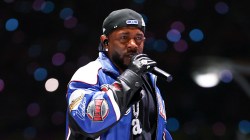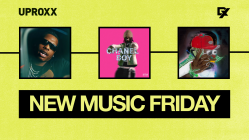Rewind back to 2006. Fresh off of verses about Jay-Z [click to read] Blue and business, man, the Hip Hop world was in a literal fervor upon hearing that one Shawn Carter was going to end his short retirement. And just as these things tend to go, Jay-Z had to ask himself – once again – “What more can I say?”
Upon the release of 2006’s Kingdom Come [click to read], something happened that not even Hov could’ve entirely expected: for the first time since he garnered near-universal (if not critical) acceptance on Vol. 2… Hard Knock Life, Jay-Z’s album was met with modest fanfare at best. Some criticisms were unfounded, and some were not. But one thing was certain: Jay wasn’t quite comfortable in his own skin on Kingdom Come, not knowing how to consistently reconcile his newfound subject matter with rhymes and production to create a well-executed album. In a rare act of self-consciousness, Jay-Z took these criticisms – and his own doubts – to heart. As a result, he allowed his subject matter to regress to street tales on the excellent American Gangster [click to read]. While Jay used the movie of the same name as an excuse, it’s clear that he wanted to re-instill both himself and his fans with confidence that a product by S. Dot was a worthwhile one.
All this is very important to consider when one realizes that The Blueprint 3 – follow-up to Jay’s 2001 classic [click to read] and its 2002 not-so-classic sequel [click to read] – is the album that Kingdom Come was meant to be. “I’m talking ‘bout life…and all I hear is ‘Oh yeah he keeps talkin’ bout crack!” Hov rhymes in the album’s intro, “What We Talkin’About,” affirming his commitment to progressing this time around.
The show continues with the somewhat-controversial “D.O.A. (Death Of Auto-Tune)” [click to view], a condemnation of not only Hip Hop’s latest and favorite crutch, but of all over-saturated trends that get run into the ground. No I.D. [click to read] is at his best here, marrying a heavy electric guitar loop with intermittent Klezmer clarinet. Blueprint 3’s Rock influences extend onto “Run This Town,” featuring Kanye West and Rihanna. Here, the multi-platinum trio claims the throne – but no one does a better job of it than Kanye’s beat. As the very best producers know, and Kanye is certainly among that group, the best production is that which tells a story before the first verse drops. The epic drums, piano keys and guitar practically evoke Jay’s famous “I will not lose” mantra. On “Empire State of Mind” [click to listen], far and away the album’s gem, Jay-Z’s expertly-told Horatio Alger story and the pure emotion evoked by Alicia Keys’ chorus over Shux’ soulful keys and drums ensure an instant classic that enters Hip Hop’s annals alongside previous Jay-Z triumphs “Hard Knock Life” and “Izzo.”
After “Real As It Gets,” which ends up being a disappointment relative to previous Jay-Z/Young Jeezy [click to read] collaborations, Swizz Beatz [click to read] provides an effective change-of-pace song in “On To The Next One.” While the track’s usefulness will be relegated solely to the clubs, it opens the door for a few futuristic, synth-laden cuts. “Off That” [click to listen], “Venus Vs. Mars” [click to listen], and “Reminder” [click to listen] all helmed by frequent collaborator Timbaland are three such examples. The first of the three features an energetic Jay spitting with Drake on the chorus in what turns out to be another one for the clubs, while the latter two are a bit darker. Although the production by itself for the cuts isn’t terrible, the tracks rate among the worst Jay-Z/Timbaland works (and rate nowhere near “Dirt Off Your Shoulder,” “Hola Hovito,” “Big Pimpin” and “Snoopy Track,” for example). And although they afford BP3 a little more range, they’re certainly not on the same level as the rest of the album. The Kanye-produced “Hate” [click to listen] is also fairly forgettable, falling in line with Timbaland’s offerings.
Not to be forgotten is “Already Home,” which vies for best cut on the album. Not only does Kid Cudi assist with a stellar chorus, but Jay comes back down to Earth to show some indignation: “And really the fact is/ We’re not in the same bracket/ Not in the same league, don’t shoot at the same baskets/ Don’t pay the same taxes, hang out with the same bitches/ So how am I in the way? What is it that I’m missing?” Jay concludes Blueprint 3 with an assist from Mr. Hudson on “Forever Young” (double-meaning, perhaps?). The song takes Jay into ethereal nostalgia territory, much like Kingdom Come’s “Beach Chair,” and he manages again to handle it without being contrived. It’s an effective closer, albeit a bold cover of the Alphaville 1984 hit. “Bye-byes are not for legends,” rhymes Hov, leaving promise of more music to come.
Some may criticize Jay-Z for completely buying into his own mythos with this album. But unless you’ve disliked him since he first came on the scene in ’96, that thinking is flawed. Jay‘s number one fan has always been Jay – and that’s not going to change. Whether he’s spinning street tales or casting off Hip Hop’s latest overdone trends, Jay-Z‘s self-confidence is always going to be a central theme at the forefront of his music – it’s nonsensical to suddenly start holding it against him now. Blueprint 3 may not stack up to the storied first entry in the series, but it’s certainly a worthwhile contributor. And for those that want the “old” Jay-Z back: “Hov on that new shit/ Niggas like ‘how come?’/ Niggas want my old shit/ Buy my old album.”





![50 Cent Shares Unseen Diddy Footage From Netflix Documentary: "[It] Shows You His Character"](https://hiphopdx.com/wp-content/uploads/2025/12/50-cent-diddy-documentary-trailer-unseen-footage.jpg?w=250)




NAS is G.O.A.T., he’s taking his rightful postion, in front of jay. with three beautiful albums in a row. and i am counting distant relatives. thats untitled and hip hop is dead right behind it.
Hell to the naw. Jay is more versatile….not hatin on the DR wit Damian marley, that is a dope album. But HOVA is the god mc…..2nd only to Pac for best alltime…..Jay does…..no such thing as Jay dont do
Jay-Z sold his soul for riches
Hip Hop is dead was really basic for NaS. The BP3 isn’t that great either though.
Nas ahead of jay… ya’ll still sippin’ ether.. the beat was sick but nas came weak with the lyrics, he said nothing new of jay on the track.. dead that..
Blueprint III has turned out to be THE album at the forefront of the world in the last 7 months.. Hate all you want.. men lie, women lie, numbers don’t.. i’d like to know how many people downloaded the album or burned it.. not to mention single downloads from itunes.. Jay will win grammy’s in two seperate years off the same album, as the singles came out before the cut off date and the album came after.. every one else “line up, please”
One of the best albums of all time!!!!!!!!JAY did it again, he didnt even need jockin jay-z for cryin out loud
Very average album, whoever thinks this is a classic clearly hasn’t had the fortune of listening to one. The Blueprint is way better than this album. This is not exactly bad but it’s not good either, has a few good tracks but nothing special. Rather listen to Reasonable Doubt, The Blueprint and The Black Album before this.
you are a certified eminem dick rider
how is that a dick rider. he said the album was average which it was very much so. 3 out of 5 maybe.
Still bumping it a year after its release forever young one of the best songs. i get pretty hype over most of the songs on this disc
5 star albumm….hov definetly killd dis one….i didnt ave d opportunity to listen to his old albums cos i was a kid den buht….i think dis album was tight nd should not be condemned or criticised…my favourite track is Off That
Great album. 4 stars!
1
4 out of 5.
Aged well. 4/5